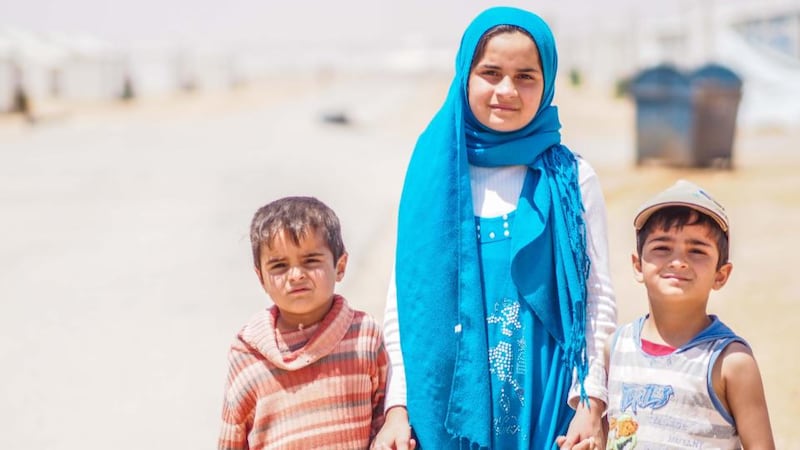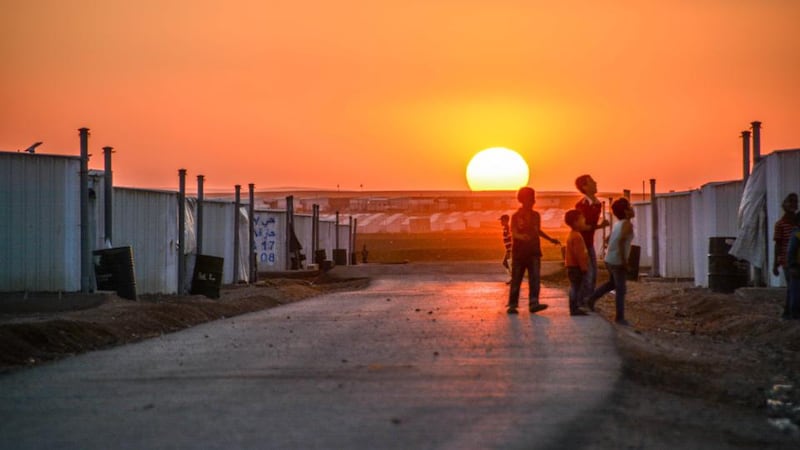In Jordan's remote northeastern desert, a barren moonscape bounded on three sides by Syria, Iraq and Saudi Arabia, the gleaming white symmetrical huts of Azraq camp could hardly look more out of place. A 90-minute drive from Amman, Jordan's capital, the camp looks like a vast, planned housing estate, its 10,000 zinc-and- steel shelters stretching endlessly over the dusty terrain.
Run by the Jordanian government and the UN refugee agency, UNHCR, the Azraq facility was opened in April 2014 to relieve pressure on the Zaatari camp, about 80km to the north. With 130,000 Syrian residents at its peak, Zaatari had grown to become one of the largest refugee camps in the world and was running out of space.
Azraq was carefully designed to avoid recreating some of the Zaatari’s flaws. Its shelters – stronger structures than the tents and caravans of Zaatari – are built to better cope with the high winds and extreme desert temperatures. A police station has been built on-site to help keep the camp secure, while efforts have been made to foster a sense of community by grouping Syrians in six “villages” by their town or region of origin.


Food
Today, all Syrians who cross into
Jordan
are brought by bus to Azraq, where they are given a shelter and 20 Jordanian dinar (€25) a month by the
World Food Programme
(WFP) through an e-card that can be used to buy food from the camp’s supermarket. The WFP also distributes four pieces of bread daily to all refugees in the camp.
Two on-site schools have capacity for 5,000 students and two primary healthcare centres are open daily.
In the spartan shelter where he has lived with his wife and three children since their arrival in late September, Mohammad, who fled the Islamic State-controlled city of Raqqa and undertook an arduous 15-day journey to the border with his family, says they “started to feel safe” as soon as they crossed the frontier.
Peace and quiet
His youngest son, Hussein, was born as they waited to cross the border, and Mohammad says the peace and quiet of the camp was just what they were looking for. “Back at home the children were not going to school, but we would like them to go to school here,” he says.
In order to establish a water supply, Unicef has drilled a 500-metre deep bore hole a few kilometres from the camp.
At present the water is transported to the camp by lorry, but after hearing a presentation on the problem last week by Fiona Ward, an Irish Unicef official based at Azraq, Minister of State Seán Sherlock said Irish Aid could assist in funding a pipeline to connect the camp to the water source.
Yet for all its improvements on Zaatari, Azraq has its own problems. Although plans are afoot to connect the camp to the power grid, its 25,000 residents have no electricity yet. Whereas Zaatari has grown into a de facto town, abuzz with markets and social life, Azraq – 90km from the Syrian border and about the same distance from Amman, Jordan’s capital – feels like an isolated outpost.
Residents say the 20 dinar allowance is insufficient and complain of a lack of privacy. Since the camp opened last year, more than 20,000 people have left.
The most striking feature of Azraq, however, is that much of it is empty. The current capacity is 50,000, and the camp has enough space and infrastructure to house up to 130,000 if required. The current population is just 25,000 – a reflection of the declining flow of refugees crossing into Jordan.
Empty shelters
The main reason for the rows of empty shelters is that it has become increasingly difficult to cross the border. Jordan, saying it fears Islamist fighters may enter the country with the refugees, has made it more difficult to gain entry. The
United States
says more than 3,000 displaced Syrians have been stranded for months at the border without proper food or shelter, and accuses Amman of denying them access.
Jordan claims there are fewer than 1,000 refugees, and that some of them could be radicals. It also says the flow has not been cut off entirely and that heavy fighting has made the crossing more dangerous.
Western states, most of which have themselves been slow to admit Syrian refugees, are doubly reluctant to criticise Amman publicly, given its importance as an ally in the fight against Islamic State.
Aid agencies say the majority of those who left Azraq have settled in Jordanian towns and cities, where more than 85 per cent of Syrian refugees – unable to work and often in debt – are living below the poverty line. Their situation has worsened in recent months, with 229,000 living outside refugee camps having had their aid from the WFP cut due to a shortage of donations.
Many of those with savings or assets are attempting the journey to Europe. For others, according to the UN, returning to the war zone has become an increasingly popular option. In July, the average rate of return to Syria was 66 a day. Today it is more than 100. The daily flow in the other direction has fallen to just 40-60 people.
“ If people are forced to go back to Syria,” says one foreign official based in Jordan, “then we have failed.”

















